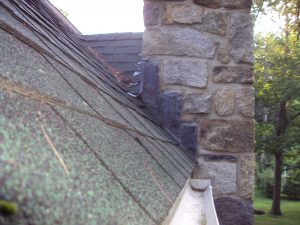Dirty Chimney Water Dripping on Basement Floor Due to Condensation Dripping Down Stainless Steel Chimney Liner
By Mark J. Donovan
|
|
We recently purchased a new home and I’ve discovered an issue with the home’s stainless steel chimney liner. Frequently on cold days when the furnace is kicking off and on, we notice dirty water dripping out of the chimney liner’s elbow near the furnace. At first I thought the problem was associated with a chimney cap that had failed, as the cap actually blew off the roof after a strong rain and wind storm. We promptly had a new chimney cap installed and the problem still persisted.
Finally, I brought an HVAC contractor in to take a look at the problem. After spending only a minute looking at our situation he explained that one of the problems with stainless steel chimney liners is that they are prone to condensation issues. |
As hot home heating oil gas emissions go up the chimney they cool and particularly so on colder days. As the gas emissions cool they condense and form water droplets on the inner side walls of the stainless steel chimney liner. The water droplets then drip downwards in the stainless steel chimney liner.
With clay or masonry chimney liners condensation issues in the chimney liner is not an issue. There is less condensation formed as the hot furnace gasses are expelled up the chimney, because the clay and masonry chimney liners have better insulating properties. Second, any condensation that does form is quickly absorbed by the clay or masonry chimney walls as it starts to drip down the chimney. As a result, the moisture never makes it down to the steel flue pipe that connects the furnace to the masonry chimney.
| One final negative aspect of the stainless steel chimney liner is that the dirty gas emissions that do exit the chimney often end up staining the roof of the home near the chimney. The stain is a brown rusty color. Then when it rains, the dirty brown rust chimney exhaust that is on the roof, ends up dripping down the roof and over the roof edge. In my case, I have a deck just below the roofline where the dirty water drips down. The roof run off then stains the deck a brown rust color.
In addition, the water bounces up off the deck and onto the side of the home leaving a rust looking stain on the house siding. Consequently once a year I need to scrub or repaint the deck and the side of the home to eliminate the discoloring. |
 |
So if you are planning to build a home think long and hard before choosing to go with a stainless steel chimney liner. Yes they are cheaper to install than a masonry chimney, but at least with a masonry chimney you won’t have to live with the annoying effects I just described of a stainless steel chimney liner.
For information on Restoring Baseboard Heating Element Covers, see the Restoring Baseboard Heating Element Covers eBook from HomeAdditionPlus.com. The Restoring Baseboard Heating Element Covers Ebook provides easy to understand, step-by-step instructions, on how to restore Baseboard Heating Element Covers so that they look new again. Pictures are included for every key step in the process.
For information on how to maximize a wood stove’s heating efficiency, see HomeAdditionPlus.com’s Installation of Hood over Wood Stove eBook.
Related Information
Additional Heating and Cooling Resources from Amazon.com
 |
 |
Free Heating and Cooling Price Quotes with No Obligation!
Fill out our 3-5 minute quick and easy form, and receive a free price quote on heating & cooling from one of our pre-screened and licensed HVAC contractors. This process is free and there is no obligation to continue once you receive your heating & cooling price estimate.

